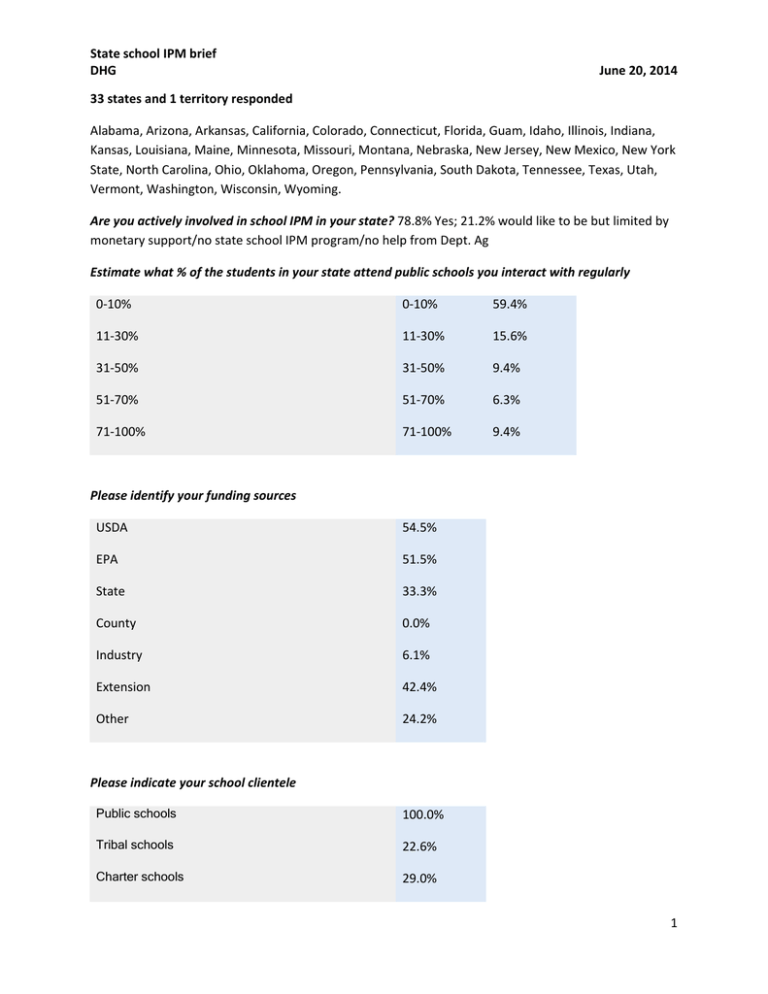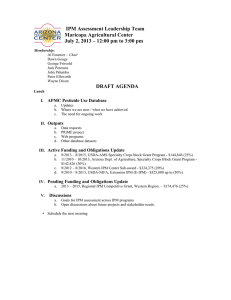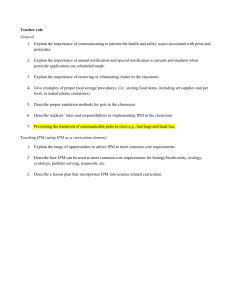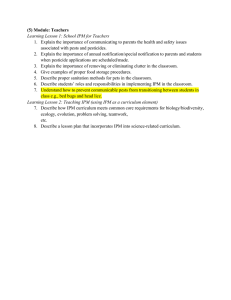State school IPM brief DHG June 20, 2014
advertisement

State school IPM brief DHG June 20, 2014 33 states and 1 territory responded Alabama, Arizona, Arkansas, California, Colorado, Connecticut, Florida, Guam, Idaho, Illinois, Indiana, Kansas, Louisiana, Maine, Minnesota, Missouri, Montana, Nebraska, New Jersey, New Mexico, New York State, North Carolina, Ohio, Oklahoma, Oregon, Pennsylvania, South Dakota, Tennessee, Texas, Utah, Vermont, Washington, Wisconsin, Wyoming. Are you actively involved in school IPM in your state? 78.8% Yes; 21.2% would like to be but limited by monetary support/no state school IPM program/no help from Dept. Ag Estimate what % of the students in your state attend public schools you interact with regularly 0‐10% 0‐10% 59.4% 11‐30% 11‐30% 15.6% 31‐50% 31‐50% 9.4% 51‐70% 51‐70% 6.3% 71‐100% 71‐100% 9.4% Please identify your funding sources USDA 54.5% EPA 51.5% State 33.3% County 0.0% Industry 6.1% Extension 42.4% Other 24.2% Please indicate your school clientele Public schools 100.0% Tribal schools 22.6% Charter schools 29.0% 1 State school IPM brief DHG June 20, 2014 Parochial schools 22.6% Military schools 9.7% Home school 0.0% Please list your most significant limitation or challenge facilitating the implementation of school IPM Please list any emerging issues? 2 State school IPM brief DHG June 20, 2014 Please indicate what kind of support you provide? Classes, trainings, workshops, practicums 84.4% Newsletters, factsheets 75.0% Recognition, certification/certificates 25.0% Policy development 56.3% Continuing education units for professionals 56.3% Response to specific questions 87.5% On‐site evaluation and implementation efforts 71.9% Other 18.8% Other: An inspection process that does not have a penalty schedule associated with the regulations involved. This is for general pat not IPM in Schools. SIPM Website and bulletins Used to provide workshops & on‐site evaluations but no longer programming support activities Website and online resources. One to one school site audits for Regulatory compliance Training materials provided to requesting trainers Do you work in other areas? Housing/residential IPM 53.6% Childcare facilities 46.4% Medical facilities 10.7% Sheltered accommodations 21.4% Landscape/parks 39.3% Other 28.6% 3 State school IPM brief DHG Other: June 20, 2014 In New Jersey Pre‐Kindergarten Schools are included in the State School IPM Law, they are often thought of as daycare centers, which they may be, but if they are also a pre‐school they must do school IPM Agricultural IPM Municipal pest control IPM for vegetables, fruits, nursery, greenhouse crops; landscapes, consumers Agronomic crops, forestry, university instruction, University Regulate pesticide use Agriculture, greenhouse and nursery industries Are you involved in a funded regional Work Group? Yes, I am 47.1% No, I was never involved 17.6% No, I used to be but not anymore 35.3% Are you currently involved in any of the EPA school IPM grant projects? Yes, I am 47.1% No, I was never involved 23.5% No, I used to be but not anymore 17.6% No, I would like to be but 11.8% (please specify) Specify: Stop School Pests We received funding from the IPM Institute of North America ‐ not sure if that is EPA funding. Not yet 4 State school IPM brief DHG June 20, 2014 I do not work with the EPA program on Guam and know little about what they do. My comments to this survey should not be construed as an accurate report of school IPM activities in our region. I am indirectly involved in an advisory capacity with 2 of the grant projects. the proposal on which I would have been involved directly as a cooperator was not selected for funding. iSchool Pest Manager and New Orleans School IPM project Building sustainable school IPM inside and out: Developing and implementing standardized training materials and IPM proficiency exams for certification Texas A&M EPA grant 5




